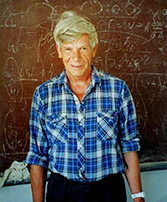Speaker
Description
The Standard Model (SM) has been tested and confirmed by many experiments.
Nowadays, the focus has shifted beyond the SM by seeking
new particles and new interactions. No new particles were observed
directly at the Large Hadron Collider (LHC) at CERN.
However, there are indirect hints for new physics (NP).
Among them semileptonic B-meson decays via charged current
(branching fractions are of order $10^{-3}$),
and rare B-meson decays via flavor changing neutral current
(branching fractions are of order $10^{-6}$).
All deviations from experiments (the so-called B-anomalies) admit an
interpretation in terms of Lepton Flavor Universality Violation.
At present time, effective theories are reliable tools for attempts to explain
B-anomalies.
We are analyzing new physics in the semileptonic decays
$B \to D^{(\ast)}\tau \nu_\tau$,
$B_c^+ \rightarrow J/\psi \tau^+ \nu_{\tau}$
($b-c$ transition), and in the rare decays
$B \to K^{(\ast)} \mu^+\mu^-$, $B_s \to \phi\mu^+\mu^-$,
$B \to K^{(\ast)} +\nu\bar\nu$.
($b-s$ transition).
We extend the Standard Model
by taking into account right-handed vector (axial), left- and right-handed
(pseudo)scalar, and tensor current contributions.
The necessary transition form factors are calculated in the full kinematic
$q^2$ range by employing a covariant quark model developed by us.
We provide constraints on NP operators based on
measurements of the ratios of branching fractions
and consider the effects of these operators on physical observables in
different NP scenarios.
A confirmation of new physics contributions in these decays would
change our understanding of matter and trigger an intense program
of experimental and theoretical research.

